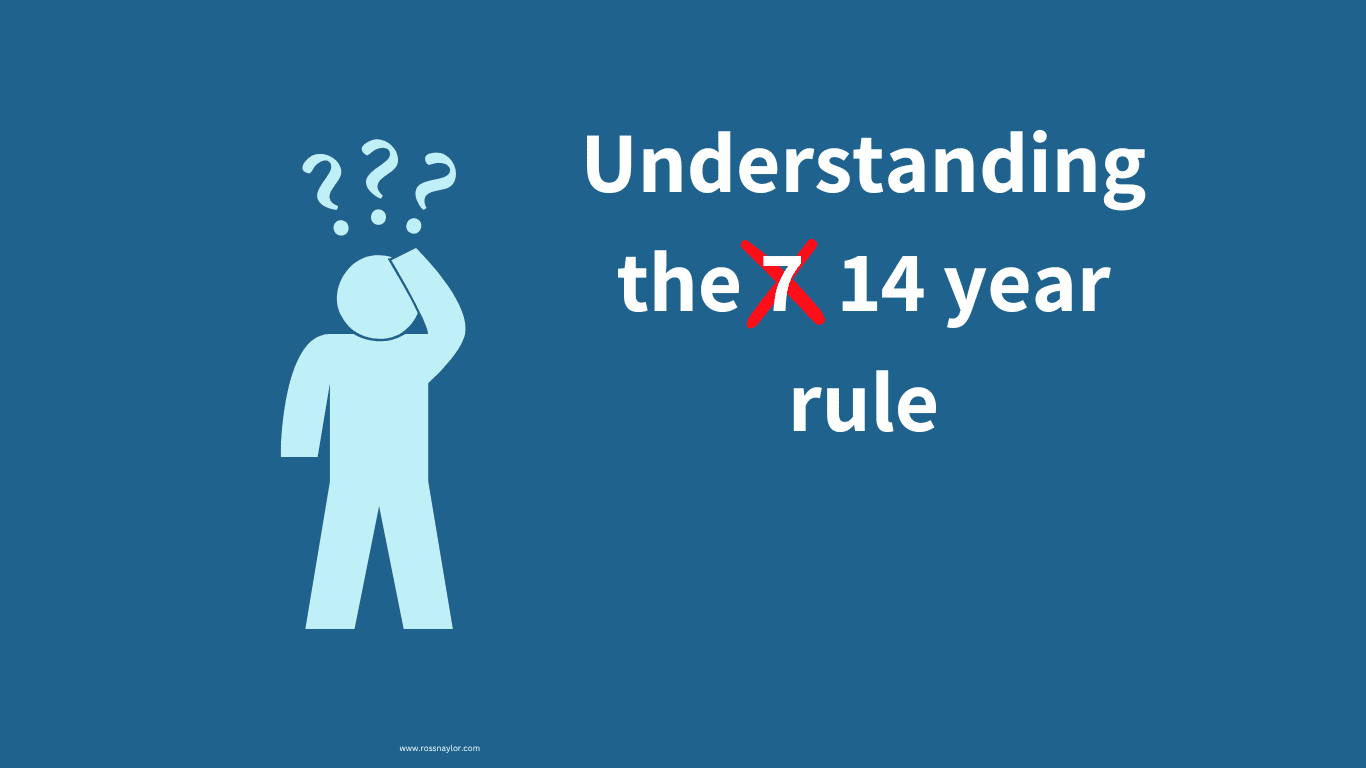
Beyond the 7-Year Rule: How the 14-Year Rule Impacts Your IHT Planning
When it comes to UK inheritance tax (IHT) planning, many of us have heard about the seven-year rule.
It’s a well-known part of the tax code that says if you give away assets during your lifetime, and survive for seven years after making the gift, those assets will typically be exempt from IHT when you pass away.
But there’s another, less familiar rule that can complicate matters—the 14-year rule.
If you’re serious about protecting your estate from unnecessary tax, this rule is something you need to understand.
Let’s dive deeper into what the 14-year rule is, how it works, and why it might matter more than you think.
The Basics of the 7-Year Rule
Before getting into the 14-year rule, let’s quickly recap the more commonly known 7-year rule.
In simple terms, under UK inheritance tax law, if you give away assets or make gifts to family or friends, these gifts are referred to as potentially exempt transfers (PETs).
If you survive for seven years after making the gift, the value of that gift is no longer included in your estate when calculating IHT.
This means that, provided you live long enough, your beneficiaries could avoid paying inheritance tax on those assets altogether.
However, if you die within seven years of making the gift, the value of the gift is added back into your estate, potentially triggering an IHT liability.
There are also “taper relief” provisions, which reduce the amount of tax due on gifts made between three and seven years before death.
So, What’s the 14-Year Rule?
While the seven-year rule is widely known, the 14-year rule is often overlooked, but it can have significant implications for those looking to reduce their IHT bill.
The 14-year rule doesn’t replace the seven-year rule; rather, it adds an extra layer of complexity, especially when trusts and multiple gifts are involved.
Essentially, the 14-year rule comes into play if you’ve made what’s called a chargeable lifetime transfer (CLT), which usually refers to gifts made into certain types of trusts.
Here’s where things can get tricky: if you make a gift to a trust (a CLT) and then make another gift within seven years of that, you may inadvertently extend the period over which IHT might be charged, bringing earlier gifts into account.
In other words, if you pass away within seven years of making a second gift (a PET), the tax authorities will look back not just at that gift but also at any gifts made up to seven years before it.
This effectively creates a 14-year window in which gifts are subject to potential IHT scrutiny.

A Closer Look: How the 14-Year Rule Works
Let’s break this down further with an example to illustrate how the 14-year rule can apply.
Imagine you made a gift into a trust (a CLT) in Year 1.
In Year 8, you make a second gift to an individual (a PET).
If you die in Year 14, the second gift, made in Year 8, falls within the seven-year rule and is assessed for IHT.
But here’s the catch: the gift from Year 1 will also be factored in when calculating the IHT due on the Year 8 gift, even though it was made more than seven years before your death.
This happens because the IHT nil-rate band (the amount of your estate that is not subject to IHT, currently £325,000) is applied to gifts in chronological order.
So, if your nil-rate band was already used up by the CLT in Year 1, it won’t be available to offset the PET made in Year 8.
This can lead to a bigger IHT bill than you might have anticipated.

In case of death folder checklist
Download this free checklist to ensure your family has everything they need in case of an emergency
Whether you’ve recently become an expat, are in the process of planning to leave the UK, or have been a long term expat and are now preparing to return home, estate planning is essential. Ask yourself: if something happened to you tomorrow, would your spouse or family know where to find your key financial documents?
Why Does the 14-Year Rule Matter?
If you’re actively planning your estate and using gifts as a way to reduce your future IHT liability, it’s important to keep the 14-year rule in mind.
Failing to do so could result in an unexpected IHT charge on gifts you thought were safe from tax.
The main reason this rule exists is to prevent people from making large gifts to trusts, followed by gifts to individuals, in a way that circumvents the seven-year rule.
By linking the two types of transfers and extending the period under which they can be taxed together, the 14-year rule ensures that all relevant gifts are considered when calculating IHT.
The Impact on Your Estate and Beneficiaries
One of the key reasons why the 14-year rule is so important is that it can significantly reduce the amount of tax-free gifting you can do within your lifetime.
Without proper planning, you might unknowingly tie up your nil-rate band for a longer period than expected, leaving less room for future gifts to escape IHT.
In practical terms, this means your beneficiaries could end up with a larger IHT bill than anticipated if gifts aren’t carefully timed and structured.
It’s not just a matter of surviving seven years after making a gift, but also considering the wider implications of when and how gifts are made over a longer period.
How to Plan with the 14-Year Rule in Mind
Planning around the 14-year rule requires a thoughtful approach, especially if you’re using trusts as part of your estate strategy. Here are a few points to consider:
- Understand the interaction between different types of gifts: Gifts to trusts (CLTs) and gifts to individuals (PETs) are treated differently, so it’s important to understand how these interact and how they might affect your nil-rate band.
- Carefully time your gifts: If you’re planning on making both CLTs and PETs, you’ll need to consider the timing of these gifts to avoid unintentionally extending the IHT window from seven to 14 years.
- Seek professional advice: Because of the complexities involved, it’s a good idea to work with a financial adviser or estate planner who understands the nuances of IHT rules, including the 14-year rule.
They can help you structure your gifts in a way that minimizes your overall IHT liability.
The Bottom Line: Be Prepared for the Unexpected
The seven-year rule is just the tip of the iceberg when it comes to inheritance tax planning.
The lesser-known 14-year rule can complicate things, especially if you’re making gifts into trusts or giving substantial gifts to individuals.
By understanding how this rule works and planning accordingly, you can make sure your estate is structured in a way that maximizes tax efficiency and protects your beneficiaries from unexpected IHT liabilities.
So, the next time you think about making a gift, remember that the 14-year rule might be lurking in the background—and plan accordingly.
Understanding the 14-Year Rule in IHT Planning
FAQs
The 14-year rule extends the IHT consideration period beyond the seven-year rule, particularly when gifts involve trusts and multiple transfers.
The two rules work together, with the 14-year rule linking gifts to trusts and individual gifts, extending the potential IHT liability beyond seven years.
CLTs are gifts to trusts, whereas PETs are gifts to individuals. Both have different IHT treatment, but the 14-year rule links them together.
Yes, if the gift is part of a chain involving other gifts within the seven-year period, it can affect the IHT calculation.
Gifts made within this 14-year window may be subject to IHT, with earlier gifts potentially being considered when calculating the tax due.
The nil-rate band, which allows a certain amount of your estate to pass tax-free, may be consumed by earlier gifts, reducing its availability for later gifts.
If you make multiple gifts over time, including both CLTs and PETs, the 14-year rule could limit your tax-free gifting options and result in higher IHT liability.
If you make both CLTs and PETs, the 14-year rule could still apply, especially if these gifts are made close together in time.
Be mindful of the timing of your gifts, and consider how CLTs and PETs may overlap within the 14-year window, impacting your overall IHT liability.
Yes, given the complexity of the 14-year rule, consulting with an estate planner or tax professional is highly recommended to ensure your estate is structured optimally.

Talk to an Expert
Working out how the 7-Year Rule and the 14-Year “shadow” period interact with your past gifts, trusts, and allowances can feel confusing – but getting it wrong can mean a bigger inheritance tax bill than you expect.
I’m Ross Naylor, a UK-qualified Chartered Financial Planner and Pension Transfer Specialist with nearly 30 years’ experience helping British expats, non-doms, and globally mobile families structure gifts, trusts, and estates in a tax-efficient way.
I firmly believe your location in the world should never be a barrier to expert, impartial, and transparent financial advice you can trust.
Whether you’ve already made large gifts, set up trusts in the past, or you’re now planning new gifts and want to understand how the 14-Year Rule could bring earlier transfers back into the IHT calculation, I’ll help you map out the timeline, avoid common traps, and make confident long-term decisions.
Book a confidential consultation
